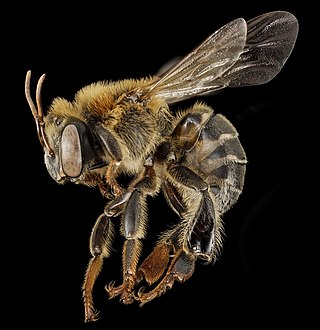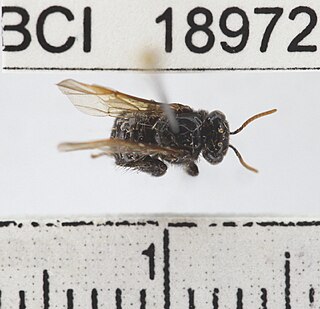
Carpenter bees are species in the genus Xylocopa of the subfamily Xylocopinae. The genus includes some 500 bees in 31 subgenera. The common name "carpenter bee" derives from their nesting behavior; nearly all species burrow into hard plant material such as dead wood or bamboo. The main exceptions are species in the subgenus Proxylocopa, which dig nesting tunnels in suitable soil.
Ptiloglossa is a small genus of bees within the family Colletidae, endemic to the Americas. Ptiloglossa is one of the most common nocturnal groups of colletids.

Plebeia is a genus of mostly small-bodied stingless bees, formerly included in the genus Trigona. Most of the ~45 species are placed in the subgenus (Plebeia) (s.s.), but there also are four species in the subgenus (Scaura). They differ in only minor structural details, primarily of the hind leg, from other genera that were formerly treated as constituents of Trigona. In some classifications, the genus Schwarziana is treated as a subgenus within Plebeia, but recent morphological analyses indicate that Schwarziana is a distinct lineage, while Plebeia is paraphyletic.

Schwarziana is a relatively small genus of South American stingless bees. Like other stingless bees, Schwarziana are eusocial, with large colonies primarily composed of workers and one queen. Unusually for stingless bees, colonies are formed in underground chambers rather than in tree cavities. Workers are approximately 6.5mm long

Melipona is a genus of stingless bees, widespread in warm areas of the Neotropics, from Sinaloa and Tamaulipas (México) to Tucumán and Misiones (Argentina). About 70 species are known. The largest producer of honey from Melipona bees in Mexico is in the state of Yucatán where bees are studied at an interactive park called "Bee Planet" which is within the Cuxtal Ecological Reserve.

Eufriesea is a genus of euglossine bees. Like all orchid bees, they are restricted to the Neotropics.

Exaerete is a genus of euglossine bees found from Mexico to northern Argentina. Like all orchid bees, they are restricted to the Neotropics. All but one species is metallic green, and they are cleptoparasites in the nests of other euglossines in the genera Eufriesea and Eulaema. It contains the following species:

Lestrimelitta is a genus of stingless bees found in the Neotropics, from Mexico to Brazil and Argentina, with about 20 known species. They are small, shining black species from 4 to 7 mm in length, with rounded heads and reduced pollen baskets. Unlike most eusocial bees, they do not gather their own pollen and nectar from flowers, thus are not pollinators, but instead they invade the colonies of other stingless bee species and rob their pollen and honey stores. They do not initiate their own nests, but they will "evict" another stingless bee colony from its nest, and convert the pre-existing nest to house their own colony.

Melipona capixaba, commonly known as uruçu negra in Brazil, is a species of eusocial stingless bees of the order Hymenoptera. It is endemic to the mountainous region of the State of Espirito Santo, Brazil. Since 2003, it has been included on the list of threatened species produced by the Brazilian Ministry of the Environment, and is the only eusocial insect on this list.

Caupolicana is a genus of bees in the family Colletidae, native to the Americas; most species are crepuscular in habit, visiting flowers only at dawn and/or dusk. There are over 50 known species, in 4 subgenera.

Triepeolus is a genus of cuckoo bees in the family Apidae. There are at least 140 described species in Triepeolus. The majority of species whose life history is known are kleptoparasitic in the nests of bees in the tribe Eucerini, especially the genera Melissodes and Svastra.

Partamona is a genus of stingless bees in the family Apidae. Herbert Ferlando Schwarz in 1938 described the genus. The genus is found from Mexico to Brazil.
Leurotrigona is a genus of bees belonging to the family Apidae.
Dolichotrigona is a genus of bees belonging to the family Apidae.
Camargoia is a genus of bees belonging to the family Apidae.
Scaptotrigona is a genus of bees belonging to the family Apidae.
Trigonisca is a genus of bees belonging to the family Apidae.
Paratrigona is a genus of bees belonging to the family Apidae.
Nogueirapis is a genus of bees belonging to the family Apidae.
Geotrigona is a genus of bees belonging to the family Apidae.










